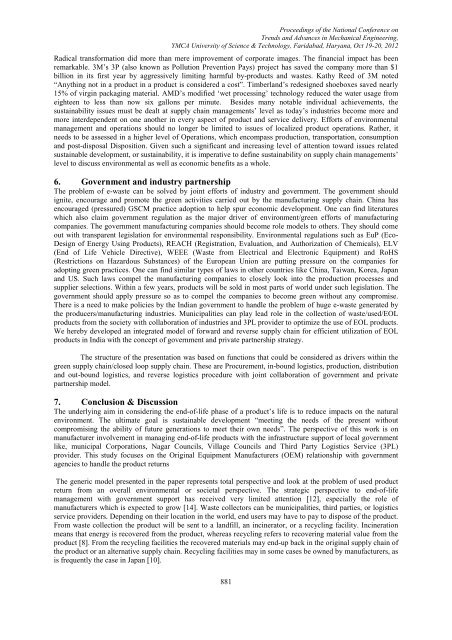IE-33 - YMCA University of Science & Technology, Faridabad
IE-33 - YMCA University of Science & Technology, Faridabad
IE-33 - YMCA University of Science & Technology, Faridabad
Create successful ePaper yourself
Turn your PDF publications into a flip-book with our unique Google optimized e-Paper software.
Proceedings <strong>of</strong> the National Conference on<br />
Trends and Advances in Mechanical Engineering,<br />
<strong>YMCA</strong> <strong>University</strong> <strong>of</strong> <strong>Science</strong> & <strong>Technology</strong>, <strong>Faridabad</strong>, Haryana, Oct 19-20, 2012<br />
Radical transformation did more than mere improvement <strong>of</strong> corporate images. The financial impact has been<br />
remarkable. 3M’s 3P (also known as Pollution Prevention Pays) project has saved the company more than $1<br />
billion in its first year by aggressively limiting harmful by-products and wastes. Kathy Reed <strong>of</strong> 3M noted<br />
“Anything not in a product in a product is considered a cost”. Timberland’s redesigned shoeboxes saved nearly<br />
15% <strong>of</strong> virgin packaging material. AMD’s modified ‘wet processing’ technology reduced the water usage from<br />
eighteen to less than now six gallons per minute. Besides many notable individual achievements, the<br />
sustainability issues must be dealt at supply chain managements’ level as today’s industries become more and<br />
more interdependent on one another in every aspect <strong>of</strong> product and service delivery. Efforts <strong>of</strong> environmental<br />
management and operations should no longer be limited to issues <strong>of</strong> localized product operations. Rather, it<br />
needs to be assessed in a higher level <strong>of</strong> Operations, which encompass production, transportation, consumption<br />
and post-disposal Disposition. Given such a significant and increasing level <strong>of</strong> attention toward issues related<br />
sustainable development, or sustainability, it is imperative to define sustainability on supply chain managements’<br />
level to discuss environmental as well as economic benefits as a whole.<br />
6. Government and industry partnership<br />
The problem <strong>of</strong> e-waste can be solved by joint efforts <strong>of</strong> industry and government. The government should<br />
ignite, encourage and promote the green activities carried out by the manufacturing supply chain. China has<br />
encouraged (pressured) GSCM practice adoption to help spur economic development. One can find literatures<br />
which also claim government regulation as the major driver <strong>of</strong> environment/green efforts <strong>of</strong> manufacturing<br />
companies. The government manufacturing companies should become role models to others. They should come<br />
out with transparent legislation for environmental responsibility. Environmental regulations such as EuP (Eco-<br />
Design <strong>of</strong> Energy Using Products), REACH (Registration, Evaluation, and Authorization <strong>of</strong> Chemicals), ELV<br />
(End <strong>of</strong> Life Vehicle Directive), WEEE (Waste from Electrical and Electronic Equipment) and RoHS<br />
(Restrictions on Hazardous Substances) <strong>of</strong> the European Union are putting pressure on the companies for<br />
adopting green practices. One can find similar types <strong>of</strong> laws in other countries like China, Taiwan, Korea, Japan<br />
and US. Such laws compel the manufacturing companies to closely look into the production processes and<br />
supplier selections. Within a few years, products will be sold in most parts <strong>of</strong> world under such legislation. The<br />
government should apply pressure so as to compel the companies to become green without any compromise.<br />
There is a need to make policies by the Indian government to handle the problem <strong>of</strong> huge e-waste generated by<br />
the producers/manufacturing industries. Municipalities can play lead role in the collection <strong>of</strong> waste/used/EOL<br />
products from the society with collaboration <strong>of</strong> industries and 3PL provider to optimize the use <strong>of</strong> EOL products.<br />
We hereby developed an integrated model <strong>of</strong> forward and reverse supply chain for efficient utilization <strong>of</strong> EOL<br />
products in India with the concept <strong>of</strong> government and private partnership strategy.<br />
The structure <strong>of</strong> the presentation was based on functions that could be considered as drivers within the<br />
green supply chain/closed loop supply chain. These are Procurement, in-bound logistics, production, distribution<br />
and out-bound logistics, and reverse logistics procedure with joint collaboration <strong>of</strong> government and private<br />
partnership model.<br />
7. Conclusion & Discussion<br />
The underlying aim in considering the end-<strong>of</strong>-life phase <strong>of</strong> a product’s life is to reduce impacts on the natural<br />
environment. The ultimate goal is sustainable development “meeting the needs <strong>of</strong> the present without<br />
compromising the ability <strong>of</strong> future generations to meet their own needs”. The perspective <strong>of</strong> this work is on<br />
manufacturer involvement in managing end-<strong>of</strong>-life products with the infrastructure support <strong>of</strong> local government<br />
like, municipal Corporations, Nagar Councils, Village Councils and Third Party Logistics Service (3PL)<br />
provider. This study focuses on the Original Equipment Manufacturers (OEM) relationship with government<br />
agencies to handle the product returns<br />
The generic model presented in the paper represents total perspective and look at the problem <strong>of</strong> used product<br />
return from an overall environmental or societal perspective. The strategic perspective to end-<strong>of</strong>-life<br />
management with government support has received very limited attention [12], especially the role <strong>of</strong><br />
manufacturers which is expected to grow [14]. Waste collectors can be municipalities, third parties, or logistics<br />
service providers. Depending on their location in the world, end users may have to pay to dispose <strong>of</strong> the product.<br />
From waste collection the product will be sent to a landfill, an incinerator, or a recycling facility. Incineration<br />
means that energy is recovered from the product, whereas recycling refers to recovering material value from the<br />
product [8]. From the recycling facilities the recovered materials may end-up back in the original supply chain <strong>of</strong><br />
the product or an alternative supply chain. Recycling facilities may in some cases be owned by manufacturers, as<br />
is frequently the case in Japan [10].<br />
881













